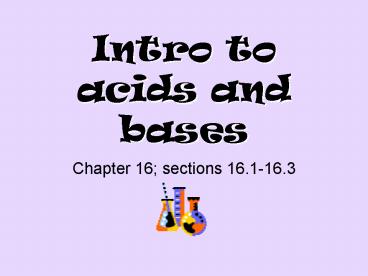Intro to acids and bases - PowerPoint PPT Presentation
1 / 18
Title:
Intro to acids and bases
Description:
Amphoteric substance can behave as either acid or base. Ionization of water ... You know that water is amphoteric (acting as acid and base) ... – PowerPoint PPT presentation
Number of Views:293
Avg rating:3.0/5.0
Title: Intro to acids and bases
1
Intro to acids and bases
- Chapter 16 sections 16.1-16.3
2
Review
- What makes something an acid?
- What makes something a base?
- Give examples of acids and bases?
- What is the way we measure the strength of an
acid or a base?
3
Properties of Acids and Bases
- Acids have very distinct properties
- They taste sour
- Lemon, vinegar
- They are corrosive to metal
- Bases also have distinct properties
- They are bitter
- Feel slippery
- Hand soap
4
Properties of Acids and Bases cont
- 1st discoveries of Acids Bases made by Svante
Arrhenius. - Arrhenius Model
- Acids produce H ions
- HCl ? H Cl-
- Bases produce OH- ions
- NaOH ? Na OH-
5
Properties of Acids and Bases cont
- Bronsted Lowry Model improved upon Arrhenius
model - Before only OH ions could be base
- In this model, the acid is a PROTON (H) DONOR,
and the base is a PROTON ACCEPTOR - HA H2O ? H3O A-
- Acid Base Conjugate
acid Conjugate base - Acid is proton donor (H)
- Base is proton acceptor (H)
- Conjugate Acid (H3O)
- Conjugate Base (A-)
6
Properties of Acids and Bases cont
- Wait! How can water act as a base?
- Remember that when you draw the Lewis dot
structure of water that the oxygen has 2 lone
pairs of electrons? - When an acid (something that has a H ion) is
reacted with it, then that extra H can attach to
one of the lone pairs. - This is called a hydronium ion
7
Properties of Acids and Bases cont
- Lets try to name the parts of a Bronsted-Lowry
acid base reaction! - HCl H2O ? H3O Cl-
- Name the acid, base, conjugate acid, conjugate
base - Answer
- Acid is proton donor (HCl)
- Base is proton acceptor (H2O)
- Conjugate Acid (H3O)
- Conjugate Base (Cl-)
8
Properties of Acids and Bases cont
- A conjugate acid-base pair consists of the two
substances that are related to each other by
donating and accepting a single proton
9
Properties of Acids and Bases cont
- HClO4 H2O ?
- What would be the conjugate acid pair?
- What would be the conjugate base pair?
- HClO4 H2O ? H3O ClO4-
- Acid- Conjugate base pair HClO4 ? ClO4-
- Base- Conjugate acid pair H2O ? H3O
10
Acid Strength
- Can the reaction go backwards?
- H3O A- ? HA H2O
- Yes, it depends on the strength of the acid
base - If the reaction goes in both directions it is
represented with double arrows - HA H2O ? H3O A-
- Acid Base Conjugate acid
Conjugate base - A strong acid is one in which the forward
reaction predominates - A weak acid is one in which the reverse reaction
predominates
11
Acid Strength Cont
12
Relationship of acid strength and conjugate
base strength for the dissociation reaction.
13
Acid Strength
- There are various ways to describe the strength
of an acid - Sulfuric acid can actually supply 2 protons, this
is called a diprotic acid - Most acids are called oxyacids which means the
acidic hydrogen is attached to an oxygen atom - Organic acids contain a carbon backbone
14
Water can act as an acid or a base
- Amphoteric substance can behave as either acid
or base - Ionization of water
- H2O H2O ? H3O OH-
- Actually, its not at a perfect equilibrium. It
prefers to be H2O - Thus the arrow is both directions, but the sizes
of the arrow would be more like this - ? and ?
- In pure water only tiny amounts of OH and H3O
exist - Sometimes H3O is written as H
15
Flashback to last unit
- If we know that.
- NaCl ? Cl- Na
- And that 1M NaCl means 1M Cl- and 1M Na
- Then when applying this to the dissociation of
water the same rule applies - H2O H2O ? H3O OH-
- If the concentration of H3O is 1.0 x 10-7 M,
what is the concentration of OH-? - Answer 1.0 x 10-7 M
16
What you need to know
- Anytime you see
- H2O H2O ? H3O OH-
- You know that water is amphoteric (acting as acid
and base) - Concentration of H30 OH- 1.0x 10-7 M
- Multiplying the concentration of H3O x OH- will
always equal 1.0 x 10-14 M
17
What you need to know cont.
- A neutral solution, where H30 OH-
- An acidic solution, where H3O gt OH-
- A basic solution, where H3O lt OH-
- But
- Try one
- If H3O concentration is 1.0 x 10-8 M what is the
solution? - H x OH- 1.0 x 10 -14
- 1.0 x 10-8 x OH-1.0 x 10 -14
- OH 1.0 x10-6
18
Homework
- Read Pages 502-513. Problems 1-5 on page 513
problems 9 and 22 on page 532-533































